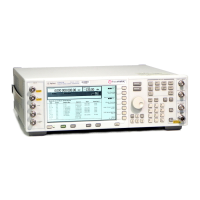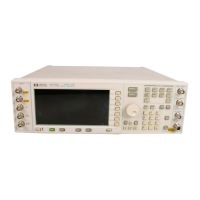SCPI COMMAND SUMMARY
CORRection:FLATness {<num>[freq suffix],<num>[DB]}2*801
CORRection:FLATness?
Sets and queries an array of up to 801 frequency-correction
pairs. This correction information is used to create a correction
array that can be added to the internal calibration array. The
correction entered is at the asso ciated frequency.Frequencies in
between frequency-correction pair values are determined by linear
interpolation. If a value of START or STOP frequency is sp ecied
that is outside the limits of the specied frequencies, the correction
applied at those points is 0 dB. After *RST, returns a
MinFreq, 0 DB, MaxFreq, 0 DB
response.
CORRection:SOURce[i] ARRay|FLATness
CORRection:SOURce[i]?
Sets and queries the source of correction.
CORRection:FLATness:POINts? [MAXimum|MINimum]
Returns the number of frequency-correction pairs entered using the
CORR:FLAT
command. After *RST, the value is 2.
CORRection[:STATe] ON|OFF|1|0
CORRection[:STATe]?
Sets and queries the switch on the users ALC correction system.
The *RST value is OFF.
DIAGnostics:ABUS? <num>
Reads the analog bus no de number and returns the number of
millivolts.
DIAGnostics:ABUS:AVERage <num>
DIAGnostics:ABUS:AVERage?
Sets and queries the number of ADC averages to use during the read
ADC query. After *RST, the value is 1.
DIAGnostics:ABUS:STATus?
Queries the status of the prior ADC reading. The response is a single
byte that is bit-enco ded to mean:
Bit 0 Set to 1, if ADC timed out (hardware fault).
Bit 1 Set to 1, if reading was unsettled.
Bit 2 Set to 1, if out of range o ccurred.
S-30 Operating and Programming Reference

